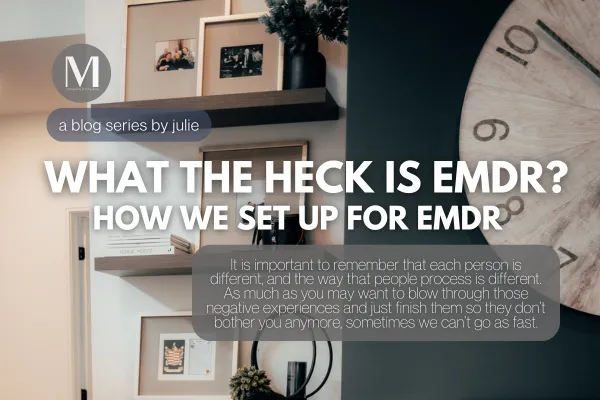the blog
A place for our team to share about topics they are passionate about, in hopes of allowing you to see and understand a bit more behind the faces on these pages.

What the Heck is EMDR? How We Set up for EMDR
Each therapist is going to set up your EMDR sessions differently depending on what you’re coming in with, how you process, the relationship you have, etc. Typically we gather a trauma history, do some resourcing, set up a target sequence plan and then we jump into processing.
Gathering a trauma history can look several different ways. Sometimes we collect information based on themes. For example, if you want to work on a consistent experience of conflict in relationships, we may go through your history exploring different occurrences of conflict in relationships that feel distressing for you. We may do it based on relationships that were very conflictual for you. We could pick one parental figure or caregiver and go through the relationship identifying specific occurrences that reinforce specific feelings or beliefs that you have about yourself. We may do it based on an emotion and how one emotion has shown up consistently throughout your life, or we may pick a negative belief and explore occurrences in your life that reinforced that negative belief about yourself.
Resourcing often introduces the idea of bilateral stimulation, what your preference is for bilateral and what feels the most comfortable for you. We try eye movements, tapping, beeping sounds, and pulsers to see what you prefer. Often clients wonder how they’ll know, I don’t know what to tell you other than: people know. They know what they like and what they don’t and their bodies will tell them whether they find specific types of bilateral stimulation annoying or not. With resourcing we will often explore different types of visualizations such as Calm & Peaceful Places, Containment, Wise Figures, Strength Based Micro Resourcing, and Circle of Resourcing. These are all elements of finding moments or experiences in your life that reaffirmed positive beliefs or feelings about yourself.
Target Sequence Planning is the layout of the specific events that we’re going to target using EMDR, and what order we’re going to do them in. We will often start with the earliest memory first. When we do this I find that often the rest of the experiences are easier to process as the touchstone earliest one is already done. That being said, it is always the client's choice as to what memory they want to process first.
Once we’ve completed these steps we typically jump into doing EMDR and starting to process the negative experiences. With that though, it is important to remember that each person is different, and the way that people process is different. As much as you may want to blow through those negative experiences and just finish them so they don’t bother you anymore, sometimes we can’t go as fast. We need to make sure that each person is able to regulate themselves, recognize their emotions, have healthy coping mechanisms and the self-awareness to be able to tolerate the memories and emotions that may come up during processing. Each therapist assesses along the way whether the client is ready to jump into processing or not, and it’s often an ongoing conversation between the therapist and client to ensure that the client receives the best possible care throughout their healing journey.
Stay tuned for the next blog on “What does EMDR actually look like?”
Office Location: 1200 Brock Street South, Whitby, ON. L1N 4L9
© Marquis Counselling & Consulting | ALL RIGHTS RESERVED | TERMS & CONDITIONS | PRIVACY POLICY
